NETGEAR D6400 User Manual
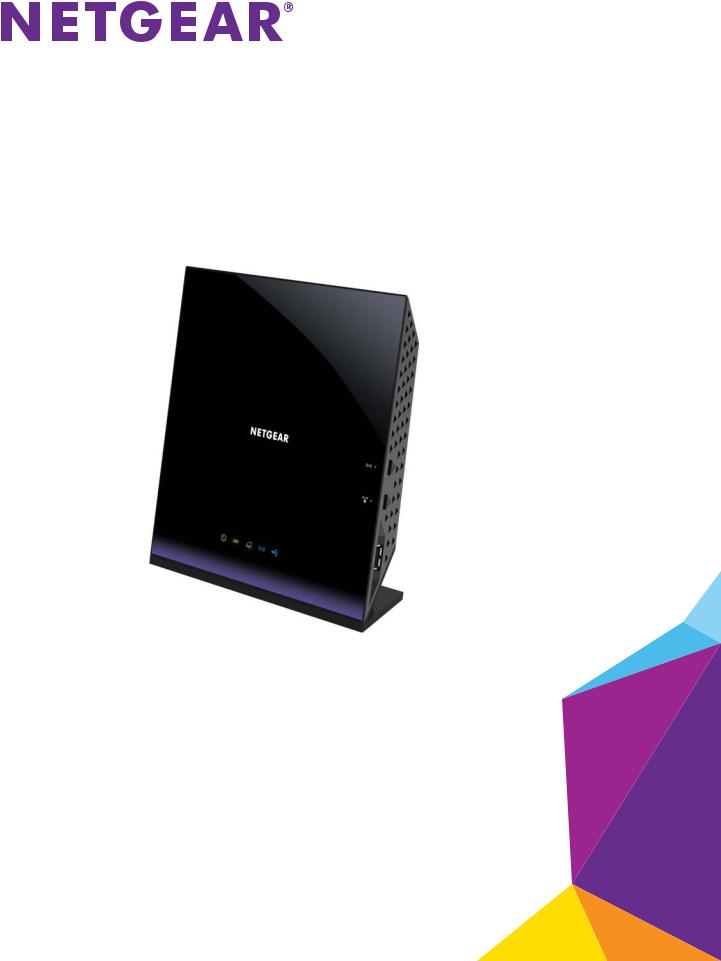
AC1600 WiFi VDSL/ADSL Modem Router
Model D6400
User Manual
August 2015 202-11485-05
350 East Plumeria Drive
San Jose, CA 95134
USA

AC1600 WiFi VDSL/ADSL Modem Router Model D6400
Support
Thank you for selecting NETGEAR products.
After installing your device, locate the serial number on the label of your product and use it to register your product at https://my.netgear.com. You must register your product before you can use NETGEAR telephone support. NETGEAR recommends registering your product through the NETGEAR website.
For product updates and web support, visit http://support.netgear.com.
Phone (US & Canada only): 1-888-NETGEAR.
Phone (Other Countries): Check the list of phone numbers at http://support.netgear.com/general/contact/default.aspx.
Compliance
For regulatory compliance information, visit http://www.netgear.com/about/regulatory.
See the regulatory compliance document before connecting the power supply.
Trademarks
© NETGEAR, Inc., NETGEAR and the NETGEAR Logo are trademarks of NETGEAR, Inc. Any non-NETGEAR trademarks are used for reference purposes only.
2

Contents
Chapter 1 Hardware Overview of the Modem Router
Unpack Your Modem Router . . . . . . . . . . . . . . . . . . . . . . . . . . . . . . . . . . . . . . . . . . 10 Front Panel with LEDs . . . . . . . . . . . . . . . . . . . . . . . . . . . . . . . . . . . . . . . . . . . . . . . . 11 Back Panel with Ports, Buttons, and Connector . . . . . . . . . . . . . . . . . . . . . . . . . . 13 Right Side Panel with WPS and WiFi On/Off Buttons and USB Port . . . . . . . . . 14 Bottom Panel Product Label . . . . . . . . . . . . . . . . . . . . . . . . . . . . . . . . . . . . . . . . . . 15
Chapter 2 Install and Access the Modem Router and Its Network
Position Your Modem Router. . . . . . . . . . . . . . . . . . . . . . . . . . . . . . . . . . . . . . . . . . 17 Connect to the Modem Router . . . . . . . . . . . . . . . . . . . . . . . . . . . . . . . . . . . . . . . . 18 Connect to the Modem Router Through an Ethernet Cable. . . . . . . . . . . . . . 18 Join the WiFi Network of the Modem Router. . . . . . . . . . . . . . . . . . . . . . . . . . 18 Types of Logins . . . . . . . . . . . . . . . . . . . . . . . . . . . . . . . . . . . . . . . . . . . . . . . . . . . . . 19 Automatic Internet Setup. . . . . . . . . . . . . . . . . . . . . . . . . . . . . . . . . . . . . . . . . . . . . 20 Set Up Your Modem Router for DSL Service. . . . . . . . . . . . . . . . . . . . . . . . . . . . . 21 DSL Service . . . . . . . . . . . . . . . . . . . . . . . . . . . . . . . . . . . . . . . . . . . . . . . . . . . . . . 21 Cable the Modem Router for DSL Service and Access the Modem Router . 22 Set Up Your Modem Router for Cable or Fiber Service . . . . . . . . . . . . . . . . . . . . 29 Log In to the Modem Router After Setup to View or Change Settings. . . . . . . 35 Change the Language . . . . . . . . . . . . . . . . . . . . . . . . . . . . . . . . . . . . . . . . . . . . . . . . 37 Change the admin Password . . . . . . . . . . . . . . . . . . . . . . . . . . . . . . . . . . . . . . . . . . 37 Set Up Password Recovery . . . . . . . . . . . . . . . . . . . . . . . . . . . . . . . . . . . . . . . . . . . 38 Let the Modem Router Automatically Update Its Firmware . . . . . . . . . . . . . . . . 39 Access the Modem Router with the NETGEAR genie App. . . . . . . . . . . . . . . . . . 40
Chapter 3 Manage the Internet Settings Manually
Use the Internet Setup Wizard After Initial Setup . . . . . . . . . . . . . . . . . . . . . . . . 42 Manually Set Up an ADSL Internet Connection . . . . . . . . . . . . . . . . . . . . . . . . . . 47 Specify an ADSL Connection Without a Login Requirement . . . . . . . . . . . . . 47
Specify an ADSL Connection with a Login Requirement and
PPPoA or PPPoE Service . . . . . . . . . . . . . . . . . . . . . . . . . . . . . . . . . . . . . . . . . . . 52 Manually Set Up a VDSL Internet Connection. . . . . . . . . . . . . . . . . . . . . . . . . . . . 57 Specify a VDSL Connection Without a Login Requirement . . . . . . . . . . . . . . 57
Specify a VDSL Connection with a Login Requirement and
PPPoE Service . . . . . . . . . . . . . . . . . . . . . . . . . . . . . . . . . . . . . . . . . . . . . . . . . . . . 61 Manually Set Up a Cable of Fiber Internet Connection . . . . . . . . . . . . . . . . . . . . 66 Specify a Cable or Fiber Connection Without a Login Requirement . . . . . . . 66
Specify a Cable or Fiber Connection With a Login Requirement
and PPPoE Service . . . . . . . . . . . . . . . . . . . . . . . . . . . . . . . . . . . . . . . . . . . . . . . . 71
3

AC1600 WiFi VDSL/ADSL Modem Router Model D6400
Specify an IPv6 Internet Connection . . . . . . . . . . . . . . . . . . . . . . . . . . . . . . . . . . . 75 IPv6 Internet Connections and IPv6 Addresses . . . . . . . . . . . . . . . . . . . . . . . . 75 Set Up an IPv6 Connection Through Auto Detect . . . . . . . . . . . . . . . . . . . . . . 76 Set Up an IPv6 6to4 Tunnel Connection . . . . . . . . . . . . . . . . . . . . . . . . . . . . . . 78 Set Up an IPv6 Pass-Through Connection . . . . . . . . . . . . . . . . . . . . . . . . . . . . 79 Set Up an IPv6 Fixed Connection . . . . . . . . . . . . . . . . . . . . . . . . . . . . . . . . . . . . 80 Set Up an IPv6 DHCP Connection . . . . . . . . . . . . . . . . . . . . . . . . . . . . . . . . . . . 82 Set Up an IPv6 PPPoE Connection . . . . . . . . . . . . . . . . . . . . . . . . . . . . . . . . . . . 84 Set Up an IPv6 Connection Through Auto Config . . . . . . . . . . . . . . . . . . . . . . 86 Set Up an IPv6 6rd Tunnel Connection . . . . . . . . . . . . . . . . . . . . . . . . . . . . . . . 88
Manage the MTU Size. . . . . . . . . . . . . . . . . . . . . . . . . . . . . . . . . . . . . . . . . . . . . . . . 90 MTU Concepts. . . . . . . . . . . . . . . . . . . . . . . . . . . . . . . . . . . . . . . . . . . . . . . . . . . . 90 Change the MTU Size . . . . . . . . . . . . . . . . . . . . . . . . . . . . . . . . . . . . . . . . . . . . . . 91
Chapter 4 Manage the WiFi Network Settings
Manage the Basic WiFi Settings and WiFi Security of the Main Network. . . . . 93 View or Change the Basic WiFi Settings . . . . . . . . . . . . . . . . . . . . . . . . . . . . . . 93 Configure WPA/WPA2 Enterprise WiFi Security . . . . . . . . . . . . . . . . . . . . . . . 98 Configure WEP Legacy WiFi Security . . . . . . . . . . . . . . . . . . . . . . . . . . . . . . . 100 Use WPS to Add a Device to the WiFi Network . . . . . . . . . . . . . . . . . . . . . . . . . 102 Use WPS with the Push Button Method . . . . . . . . . . . . . . . . . . . . . . . . . . . . . 102 Use WPS with the PIN Method . . . . . . . . . . . . . . . . . . . . . . . . . . . . . . . . . . . . . 103 Manage the Basic WiFi Settings and WiFi Security of the Guest Network . . . 105 Set Up and Enable a Guest Network . . . . . . . . . . . . . . . . . . . . . . . . . . . . . . . . 105 Configure WEP Legacy WiFi Security for the Guest WiFi Network. . . . . . . 108 Control the WiFi Radios . . . . . . . . . . . . . . . . . . . . . . . . . . . . . . . . . . . . . . . . . . . . . 110 Use the WiFi On/Off Button . . . . . . . . . . . . . . . . . . . . . . . . . . . . . . . . . . . . . . . 110 Enable or Disable the WiFi Radios. . . . . . . . . . . . . . . . . . . . . . . . . . . . . . . . . . . 111 Set Up a WiFi Schedule . . . . . . . . . . . . . . . . . . . . . . . . . . . . . . . . . . . . . . . . . . . . . . 112 Manage the WPS Settings . . . . . . . . . . . . . . . . . . . . . . . . . . . . . . . . . . . . . . . . . . . 114 Manage Advanced WiFi Features . . . . . . . . . . . . . . . . . . . . . . . . . . . . . . . . . . . . . 115 Use the Modem Router as a WiFi Access Point . . . . . . . . . . . . . . . . . . . . . . . . . . 117
Chapter 5 Control Access to the Internet
Set Up Parental Controls . . . . . . . . . . . . . . . . . . . . . . . . . . . . . . . . . . . . . . . . . . . . 120 Allow or Block Access to Your Network . . . . . . . . . . . . . . . . . . . . . . . . . . . . . . . . 121 Enable and Manage Network Access Control . . . . . . . . . . . . . . . . . . . . . . . . . 121 Manage Network Access Control Lists . . . . . . . . . . . . . . . . . . . . . . . . . . . . . . 123 Use Keywords to Block Internet Sites . . . . . . . . . . . . . . . . . . . . . . . . . . . . . . . . . 126 Set Up Blocking . . . . . . . . . . . . . . . . . . . . . . . . . . . . . . . . . . . . . . . . . . . . . . . . . . 126 Remove a Keyword or Domain from the Blocked List. . . . . . . . . . . . . . . . . . 128 Remove All Keywords and Domains from the Blocked List . . . . . . . . . . . . . 128 Specify a Trusted Computer . . . . . . . . . . . . . . . . . . . . . . . . . . . . . . . . . . . . . . . 129 Manage Simple Outbound Firewall Rules for Services and Applications. . . . . 130 Add an Outbound Firewall Rule. . . . . . . . . . . . . . . . . . . . . . . . . . . . . . . . . . . . . 130 Add an Outbound Firewall Rule for a Custom Service or Application . . . . . 132
4

AC1600 WiFi VDSL/ADSL Modem Router Model D6400
Change an Outbound Firewall Rule. . . . . . . . . . . . . . . . . . . . . . . . . . . . . . . . . . 134 Remove an Outbound Firewall Rule . . . . . . . . . . . . . . . . . . . . . . . . . . . . . . . . . 135 Set Up a Schedule for Keyword Blocking and Outbound Firewall Rules . . . . . 136 Set Up Security Event Email Notifications . . . . . . . . . . . . . . . . . . . . . . . . . . . . . . 138
Chapter 6 Optimize Performance
Optimize Traffic with Internet Access QoS . . . . . . . . . . . . . . . . . . . . . . . . . . . . . 141 Manage Default and Custom QoS Rules. . . . . . . . . . . . . . . . . . . . . . . . . . . . . . . . 142 View the Default QoS Rules. . . . . . . . . . . . . . . . . . . . . . . . . . . . . . . . . . . . . . . . 142 Create a Custom QoS Rule for an Application or Online Game . . . . . . . . . . 143 Create a Custom QoS Rule for a Modem Router LAN Port. . . . . . . . . . . . . . 145 Create a Custom QoS Rule for a MAC Address. . . . . . . . . . . . . . . . . . . . . . . . 146 Change a Default or Custom QoS Rule . . . . . . . . . . . . . . . . . . . . . . . . . . . . . . 149 Remove a QoS Rule. . . . . . . . . . . . . . . . . . . . . . . . . . . . . . . . . . . . . . . . . . . . . . . 151 Remove All QoS Rules. . . . . . . . . . . . . . . . . . . . . . . . . . . . . . . . . . . . . . . . . . . . . 151 Manage Wi-Fi Multimedia Quality of Service . . . . . . . . . . . . . . . . . . . . . . . . . . . 152 Manage Implicit Beamforming. . . . . . . . . . . . . . . . . . . . . . . . . . . . . . . . . . . . . . . . 153 Improve Network Connections with Universal Plug and Play . . . . . . . . . . . . . . 154
Chapter 7 Share a Storage Device
USB Device Requirements . . . . . . . . . . . . . . . . . . . . . . . . . . . . . . . . . . . . . . . . . . . 157 Connect a USB Device to the Modem Router . . . . . . . . . . . . . . . . . . . . . . . . . . . 157 Access a Storage Device Connected to the Modem Router . . . . . . . . . . . . . . . 158 Back Up Windows Computers with ReadySHARE Vault. . . . . . . . . . . . . . . . . . . 159 Back Up Mac Computers with Time Machine . . . . . . . . . . . . . . . . . . . . . . . . . . . 159
Set Up a USB Hard Drive on a Mac. . . . . . . . . . . . . . . . . . . . . . . . . . . . . . . . . . 159 Prepare to Back Up a Large Amount of Data . . . . . . . . . . . . . . . . . . . . . . . . . 160 Use Time Machine to Back Up onto a Storage Device. . . . . . . . . . . . . . . . . . 161 Manage Access to a Storage Device. . . . . . . . . . . . . . . . . . . . . . . . . . . . . . . . . . . 162 Enable FTP Access Within Your Network . . . . . . . . . . . . . . . . . . . . . . . . . . . . . . . 164 View Network Folders on a Device . . . . . . . . . . . . . . . . . . . . . . . . . . . . . . . . . . . . 165 Add a Network Folder on a Storage Device. . . . . . . . . . . . . . . . . . . . . . . . . . . . . 166 Change a Network Folder, Including Read and Write Access, on a USB Drive 168 Approve USB Devices . . . . . . . . . . . . . . . . . . . . . . . . . . . . . . . . . . . . . . . . . . . . . . . 170 Safely Remove a USB Device . . . . . . . . . . . . . . . . . . . . . . . . . . . . . . . . . . . . . . . . . 171
Chapter 8 Access Storage Devices Through the Internet
Set Up and Manage Dynamic DNS . . . . . . . . . . . . . . . . . . . . . . . . . . . . . . . . . . . . 174 Your Personal FTP Server . . . . . . . . . . . . . . . . . . . . . . . . . . . . . . . . . . . . . . . . . 174 Set Up a New Dynamic DNS Account. . . . . . . . . . . . . . . . . . . . . . . . . . . . . . . . 175 Specify a DNS Account That You Already Created. . . . . . . . . . . . . . . . . . . . . 176 Access Storage Devices Through the Internet . . . . . . . . . . . . . . . . . . . . . . . . . . 177 Set Up FTP Access Through the Internet. . . . . . . . . . . . . . . . . . . . . . . . . . . . . 177 Access Storage Devices Through the Internet with FTP . . . . . . . . . . . . . . . . 179
5

AC1600 WiFi VDSL/ADSL Modem Router Model D6400
Chapter 9 Use the Modem Router as a Media Server
Specify ReadyDLNA Media Server Settings . . . . . . . . . . . . . . . . . . . . . . . . . . . . 182 Play Media from a USB Device on TiVo . . . . . . . . . . . . . . . . . . . . . . . . . . . . . . . . 183
Chapter 10 Share a USB Printer
Install the Printer Driver and Cable the Printer. . . . . . . . . . . . . . . . . . . . . . . . . . 186 Download the ReadySHARE Printer Utility . . . . . . . . . . . . . . . . . . . . . . . . . . . . . 186 Install the ReadySHARE Printer Utility . . . . . . . . . . . . . . . . . . . . . . . . . . . . . . . . . 187 Use the Shared Printer . . . . . . . . . . . . . . . . . . . . . . . . . . . . . . . . . . . . . . . . . . . . . . 188 View or Change the Status of a Printer . . . . . . . . . . . . . . . . . . . . . . . . . . . . . . . . 189 Use the Scan Feature of a Multifunction USB Printer . . . . . . . . . . . . . . . . . . . . 190 Change NETGEAR USB Control Center Settings . . . . . . . . . . . . . . . . . . . . . . . . . 191
Change the NETGEAR USB Control Center Language . . . . . . . . . . . . . . . . . . 192 Specify the Time-out. . . . . . . . . . . . . . . . . . . . . . . . . . . . . . . . . . . . . . . . . . . . . 192
Chapter 11 Manage the WAN and LAN Network Settings
Change the Physical WAN Connection Preference. . . . . . . . . . . . . . . . . . . . . . . 194 Enable and Configure a VLAN . . . . . . . . . . . . . . . . . . . . . . . . . . . . . . . . . . . . . . . . 194 Set Up a Bridge for a Port Group or VLAN Tag Group . . . . . . . . . . . . . . . . . . . . 196 Set Up a Bridge for a Port Group . . . . . . . . . . . . . . . . . . . . . . . . . . . . . . . . . . . 197 Set Up a Bridge for a VLAN Tag Group . . . . . . . . . . . . . . . . . . . . . . . . . . . . . . 198 Enable Bridge Mode for an IPTV Device . . . . . . . . . . . . . . . . . . . . . . . . . . . . . . . 200 Manage the WAN Security Settings . . . . . . . . . . . . . . . . . . . . . . . . . . . . . . . . . . . 201 Set Up a Default DMZ Server . . . . . . . . . . . . . . . . . . . . . . . . . . . . . . . . . . . . . . . . 202 Manage IGMP Proxying . . . . . . . . . . . . . . . . . . . . . . . . . . . . . . . . . . . . . . . . . . . . . 203 Manage NAT Filtering . . . . . . . . . . . . . . . . . . . . . . . . . . . . . . . . . . . . . . . . . . . . . . . 204 Manage the SIP Application-Level Gateway . . . . . . . . . . . . . . . . . . . . . . . . . . . . 205 Manage the Modem Router’s LAN IP Address Settings. . . . . . . . . . . . . . . . . . . 205 Manage the Router Information Protocol Settings . . . . . . . . . . . . . . . . . . . . . . 207 Manage Reserved LAN IP Addresses . . . . . . . . . . . . . . . . . . . . . . . . . . . . . . . . . . 208 Reserve a LAN IP address . . . . . . . . . . . . . . . . . . . . . . . . . . . . . . . . . . . . . . . . . 208 Change a Reserved IP Address . . . . . . . . . . . . . . . . . . . . . . . . . . . . . . . . . . . . . 210 Remove a Reserved IP Address Entry . . . . . . . . . . . . . . . . . . . . . . . . . . . . . . . 210 Change the Modem Router’s Device Name. . . . . . . . . . . . . . . . . . . . . . . . . . . . . 211 Manage the DHCP Server Address Pool . . . . . . . . . . . . . . . . . . . . . . . . . . . . . . . 211 Disable the Built-In DHCP Server . . . . . . . . . . . . . . . . . . . . . . . . . . . . . . . . . . . . . 213 Set Up and Manage Custom Static Routes . . . . . . . . . . . . . . . . . . . . . . . . . . . . . 213 Set Up a Static Route . . . . . . . . . . . . . . . . . . . . . . . . . . . . . . . . . . . . . . . . . . . . . 214 Change a Static Route . . . . . . . . . . . . . . . . . . . . . . . . . . . . . . . . . . . . . . . . . . . . 216 Remove a Static Route . . . . . . . . . . . . . . . . . . . . . . . . . . . . . . . . . . . . . . . . . . . . 217
Chapter 12 Manage the Modem Router and Monitor the Traffic
Update the Firmware of the Modem Router. . . . . . . . . . . . . . . . . . . . . . . . . . . . 219 Check for New Firmware and Update the Modem Router . . . . . . . . . . . . . . 219 Manually Upload New Firmware and Update the Modem Router . . . . . . . . 220
6

AC1600 WiFi VDSL/ADSL Modem Router Model D6400
Manage the Configuration File of the Modem Router. . . . . . . . . . . . . . . . . . . . 222 Back Up the Settings . . . . . . . . . . . . . . . . . . . . . . . . . . . . . . . . . . . . . . . . . . . . . 222 Restore the Settings . . . . . . . . . . . . . . . . . . . . . . . . . . . . . . . . . . . . . . . . . . . . . . 222 Recover the admin Password. . . . . . . . . . . . . . . . . . . . . . . . . . . . . . . . . . . . . . . . . 223 Return the Modem Router to Its Factory Default Settings . . . . . . . . . . . . . . . . 224 Use the Reset Button . . . . . . . . . . . . . . . . . . . . . . . . . . . . . . . . . . . . . . . . . . . . . 224 Erase the Settings . . . . . . . . . . . . . . . . . . . . . . . . . . . . . . . . . . . . . . . . . . . . . . . . 225 View the Status and Statistics of the Modem Router . . . . . . . . . . . . . . . . . . . . 226
View Information About the Modem Router and the Internet,
Modem, and WiFi Settings. . . . . . . . . . . . . . . . . . . . . . . . . . . . . . . . . . . . . . . . . 226 View the Traffic Statistics . . . . . . . . . . . . . . . . . . . . . . . . . . . . . . . . . . . . . . . . . 230 View, Renew, or Release a TCP/IP Internet Connection . . . . . . . . . . . . . . . . 232 View, Connect, or Disconnect a PPPoE or PPPoA Internet Connection . . . 234 Manage the Activity Log . . . . . . . . . . . . . . . . . . . . . . . . . . . . . . . . . . . . . . . . . . . . 235 View and Manage the Log . . . . . . . . . . . . . . . . . . . . . . . . . . . . . . . . . . . . . . . . . 235 Specify Which Activities Are Logged. . . . . . . . . . . . . . . . . . . . . . . . . . . . . . . . 237 View Devices Currently on the Network . . . . . . . . . . . . . . . . . . . . . . . . . . . . . . . 237 Monitor and Meter Internet Traffic . . . . . . . . . . . . . . . . . . . . . . . . . . . . . . . . . . . 238 Start the Traffic Meter Without Traffic Volume Restrictions . . . . . . . . . . . . 238 View the Traffic Statistics and Traffic Status . . . . . . . . . . . . . . . . . . . . . . . . . 239 Restrict Internet Traffic by Volume . . . . . . . . . . . . . . . . . . . . . . . . . . . . . . . . . 240 Restrict Internet Traffic by Connection Time . . . . . . . . . . . . . . . . . . . . . . . . . 242 Unblock the Traffic Meter After the Traffic Limit Is Reached . . . . . . . . . . . 244 Manage the Modem Router Remotely . . . . . . . . . . . . . . . . . . . . . . . . . . . . . . . . . 244 Remotely Access the Modem Router Using the genie App . . . . . . . . . . . . . . . . 246 Configure the Modem Router as a DSL Modem Only . . . . . . . . . . . . . . . . . . . . 246
Chapter 13 Use VPN to Access Your Network
Set Up a VPN Connection. . . . . . . . . . . . . . . . . . . . . . . . . . . . . . . . . . . . . . . . . . . . 249 Specify VPN Service in the Modem Router . . . . . . . . . . . . . . . . . . . . . . . . . . 249 Install OpenVPN Software on Your Computer . . . . . . . . . . . . . . . . . . . . . . . . 250 Use a VPN Tunnel . . . . . . . . . . . . . . . . . . . . . . . . . . . . . . . . . . . . . . . . . . . . . . . . 252 Use VPN to Access the Modem Router’s USB Device and Media . . . . . . . . . . . 253 Use VPN to Access Your Internet Service at Home . . . . . . . . . . . . . . . . . . . . . . 254 Set Up VPN Client Internet Access in the Modem Router. . . . . . . . . . . . . . . 254 Block VPN Client Internet Access in the Modem Router. . . . . . . . . . . . . . . . 255 Use a VPN Tunnel to Access Your Internet Service at Home . . . . . . . . . . . . 256
Chapter 14 Manage Port Forwarding and Port Triggering
Manage Port Forwarding to a Local Server for Services and Applications. . . 258 Forward Incoming Traffic for a Default Service or Application . . . . . . . . . . 258 Add a Port Forwarding Rule with a Custom Service or Application. . . . . . . 259 Change a Port Forwarding Rule . . . . . . . . . . . . . . . . . . . . . . . . . . . . . . . . . . . . 261 Remove a Port Forwarding Rule . . . . . . . . . . . . . . . . . . . . . . . . . . . . . . . . . . . . 262 Application Example: Make a Local Web Server Public . . . . . . . . . . . . . . . . . 263 How the Modem Router Implements the Port Forwarding Rule . . . . . . . . . 264
Manage Port Triggering for Services and Applications . . . . . . . . . . . . . . . . . . . 264
7

AC1600 WiFi VDSL/ADSL Modem Router Model D6400
Add a Port Triggering Rule. . . . . . . . . . . . . . . . . . . . . . . . . . . . . . . . . . . . . . . . . 265 Change a Port Triggering Rule . . . . . . . . . . . . . . . . . . . . . . . . . . . . . . . . . . . . . 267 Disable or Remove a Port Triggering Rule. . . . . . . . . . . . . . . . . . . . . . . . . . . . 268 Specify the Time-Out Period for Port Triggering . . . . . . . . . . . . . . . . . . . . . 269 Disable Port Triggering. . . . . . . . . . . . . . . . . . . . . . . . . . . . . . . . . . . . . . . . . . . . 270 Application Example: Port Triggering for Internet Relay Chat . . . . . . . . . . . 271
Chapter 15 Troubleshooting
Quick Tips for Troubleshooting . . . . . . . . . . . . . . . . . . . . . . . . . . . . . . . . . . . . . . . 273 Troubleshoot with the LEDs . . . . . . . . . . . . . . . . . . . . . . . . . . . . . . . . . . . . . . . . . . 274 Power LED Remains Solid Amber . . . . . . . . . . . . . . . . . . . . . . . . . . . . . . . . . . . 274 Power LED Is Off. . . . . . . . . . . . . . . . . . . . . . . . . . . . . . . . . . . . . . . . . . . . . . . . . 275 WiFi LED Is Off . . . . . . . . . . . . . . . . . . . . . . . . . . . . . . . . . . . . . . . . . . . . . . . . . . 275 You Cannot Log In to the Modem Router . . . . . . . . . . . . . . . . . . . . . . . . . . . . . . 275 Troubleshoot the Internet Connection . . . . . . . . . . . . . . . . . . . . . . . . . . . . . . . . . 276 Troubleshoot the DSL Link. . . . . . . . . . . . . . . . . . . . . . . . . . . . . . . . . . . . . . . . . 276 Internet LED Is Off . . . . . . . . . . . . . . . . . . . . . . . . . . . . . . . . . . . . . . . . . . . . . . . 277 Obtain an Internet IP Address . . . . . . . . . . . . . . . . . . . . . . . . . . . . . . . . . . . . . . 277 Troubleshoot PPPoE or PPPoA . . . . . . . . . . . . . . . . . . . . . . . . . . . . . . . . . . . . . 278 Troubleshoot Internet Browsing . . . . . . . . . . . . . . . . . . . . . . . . . . . . . . . . . . . . 279 Changes Are Not Saved . . . . . . . . . . . . . . . . . . . . . . . . . . . . . . . . . . . . . . . . . . . . . 280 Troubleshoot the WiFi Connectivity . . . . . . . . . . . . . . . . . . . . . . . . . . . . . . . . . . . 280 Troubleshoot Your Network Using the Ping Utility . . . . . . . . . . . . . . . . . . . . . . . 281 Test the LAN Path to Your Modem Router . . . . . . . . . . . . . . . . . . . . . . . . . . . 281 Test the Path from Your Computer to a Remote Device . . . . . . . . . . . . . . . . 282
Appendix A Supplemental Information
Factory Settings . . . . . . . . . . . . . . . . . . . . . . . . . . . . . . . . . . . . . . . . . . . . . . . . . . . 284
Technical Specifications . . . . . . . . . . . . . . . . . . . . . . . . . . . . . . . . . . . . . . . . . . . . . 286
8

1. Hardware Overview of the Modem |
1 |
|
|
||
|
Router |
|
|
|
|
The NETGEAR® AC1600 WiFi VDSL/ADSL Modem Router Model D6400, in this manual referred to as the modem router, delivers WiFi connection speeds up to1 300 Mbps on 2.4 GHz 802.11n and up to 1300 Mbps on 5 GHz 802.11ac. Both 2.4 GHz and 5 GHz bands can be active simultaneously. The modem router is compatible with most major DSL Internet service providers and also supports cable or fiber Internet service.
The chapter contains the following sections:
•Unpack Your Modem Router
•Front Panel with LEDs
•Back Panel with Ports, Buttons, and Connector
•Right Side Panel with WPS and WiFi On/Off Buttons and USB Port
•Bottom Panel Product Label
Note: For more information about the topics that are covered in this manual, visit the support website at support.netgear.com.
Note: Firmware updates with new features and bug fixes are made available from time to time at downloadcenter.netgear.com. You can check for and download new firmware manually. If the features or behavior of your product does not match what is described in this guide, you might need to update your firmware.
Note: In this manual, the terms wireless and WiFi are interchangeable.
1.Actual data throughput and WiFi coverage will vary. Network conditions and environmental factors, including volume of network traffic, building materials and construction, and network overhead, lower actual data throughput rate and WiFi coverage. NETGEAR makes no express or implied representations or warranties about this product’s compatibility with any future standards.
9

AC1600 WiFi VDSL/ADSL Modem Router Model D6400
Unpack Your Modem Router
Your package contains the following items.
Ethernet cable
Modem router |
Phone cable |
Power adapter |
DSL or ADSL filter |
(varies by region) |
(varies by region) |
Figure 1. Package contents for the modem router
Your package might contain more items. The filter or phone cable provided depends on the region, and in some locations, a CD is included.
Hardware Overview of the Modem Router
10

AC1600 WiFi VDSL/ADSL Modem Router Model D6400
Front Panel with LEDs
The modem router displays status LEDs on the front panel.
Power LED
DSL LED
Internet LED
WiFi LED
USB LED
Figure 2. Modem router front panel view
Hardware Overview of the Modem Router
11

AC1600 WiFi VDSL/ADSL Modem Router Model D6400
The following table describes the LEDs from right to left and their behavior. For information about how to troubleshoot with the LEDs, see Troubleshoot with the LEDs on page 274.
Table 1. LED descriptions
LED |
Icon |
Description |
Power |
|
• Solid green. The power is on and the modem router is functioning normally. |
|
|
• Solid amber. The modem router is booting. After about one minute and 10 seconds, |
|
|
the Power LED turns solid green. |
|
|
If the LED does not turn green, a power-on self-test (POST) failure occurred or the |
|
|
modem router is malfunctioning. For more information, see Power LED Remains Solid |
|
|
Amber on page 274. |
•Blinking amber. The Reset button on the back panel is pressed.
When you release the Reset button, the Power LED blinks amber three times and then turns green as the modem router resets to the factory defaults.
•Off. The modem router is not receiving power.
DSL |
• Solid green. The modem router is providing a DSL connection. In technical terms, |
|
the DSL port is synchronized with an ISP’s network-access device. |
•Blinking green. The modem router is negotiating the best possible speed on the DSL line.
•Off. The modem router is not negotiating the speed on the DSL line and is not providing a DSL connection.
Internet |
• Solid green. The modem router is connected to the Internet. |
|
• Solid amber. The modem router failed to connect to the Internet. For more |
|
information, see Troubleshoot the Internet Connection on page 276. |
|
• Alternating green and amber. The traffic meter is enabled and the traffic limit was |
|
reached. |
|
• Off. The modem router did not detect an Internet connection or functions in bridge |
|
mode (that is, an external device handles the IP connection). |
WiFi |
• Solid blue. One or both WiFi radios are enabled and the modem router is providing |
|
WiFi connectivity. |
|
• Blinking blue. WPS (Wi-Fi Protected Setup) is active. |
|
• Off. Both WiFi radios are disabled and the modem router is not providing WiFi |
|
connectivity. You can still plug an Ethernet cable into one of the LAN ports to get |
|
wired connectivity. |
USB |
• |
Solid blue. A USB device is connected to a USB port and is ready. |
|
• |
Blinking blue. A USB device is connected to a USB port and is trying to connect. |
•Off. No USB device is connected or someone clicked the Safely Remove Hardware button, and it is now safe to remove the attached USB device.
Hardware Overview of the Modem Router
12

AC1600 WiFi VDSL/ADSL Modem Router Model D6400
Back Panel with Ports, Buttons, and Connector
The back panel of the modem router provides ports, buttons, and a DC power connector. The following figure shows only part of the back panel.
|
|
|
|
|
|
|
|
|
|
|
|
|
|
|
|
|
|
|
|
|
|
|
|
|
|
|
|
|
|
|
|
|
|
|
|
|
|
|
|
|
|
|
|
|
|
|
|
|
|
|
|
|
|
|
|
|
|
|
|
|
|
|
|
|
|
|
|
|
|
|
|
|
|
|
|
|
|
|
|
|
|
|
|
|
|
|
|
|
|
|
|
|
|
|
|
|
|
|
|
|
|
|
|
|
|
|
|
|
|
|
|
|
|
|
|
|
|
|
|
|
|
|
|
|
|
|
|
|
|
|
|
|
|
|
|
|
|
|
|
|
|
|
|
|
|
|
|
|
|
|
|
|
|
|
|
|
|
|
|
|
|
|
|
|
|
|
|
|
|
|
|
|
|
|
|
|
|
|
|
|
|
|
|
|
|
|
|
|
|
|
|
|
|
|
|
|
|
|
|
|
|
|
|
|
|
|
|
|
|
|
|
|
|
|
|
|
|
|
|
|
|
|
|
|
|
|
|
|
|
|
|
|
|
|
|
|
|
|
|
|
|
|
|
|
|
|
|
|
|
|
|
|
|
|
|
|
|
|
|
|
|
|
|
|
|
|
|
|
|
|
|
|
|
|
|
|
|
|
|
|
|
|
|
|
|
|
|
|
|
|
|
|
|
|
|
|
|
|
|
|
|
|
|
|
|
|
|
|
|
|
|
|
|
|
|
|
|
|
|
|
|
|
|
|
|
|
|
|
|
|
|
|
|
|
|
|
|
|
|
|
|
|
|
|
|
|
|
|
|
|
|
|
|
|
|
|
|
|
|
|
|
|
|
|
|
|
|
|
|
|
|
|
|
|
|
|
|
|
|
|
|
|
|
|
|
|
|
|
|
|
|
|
|
|
|
|
|
|
|
|
|
|
|
|
|
|
|
|
|
|
|
|
|
|
|
|
|
|
|
|
|
|
|
|
|
|
|
|
|
|
|
|
|
|
|
|
|
|
|
|
|
|
|
|
|
|
|
|
|
|
|
|
|
|
|
|
|
|
|
|
|
|
|
|
|
|
|
|
|
|
|
|
|
|
|
|
|
|
|
|
|
|
|
|
|
|
|
|
|
|
|
|
|
|
|
|
|
|
|
|
|
|
|
|
|
|
|
|
|
|
|
|
|
|
|
|
|
|
|
|
|
|
|
|
|
|
Reset |
|
DC power |
||
USB |
Ethernet |
|
|
||||||||||||||||||||||||||||||||||
2.0 port |
LAN ports |
|
button |
|
connector |
||||||||||||||||||||||||||||||||
|
DSL port |
|
|
|
|
|
|
|
|
|
|
|
|
|
|
|
|
Power |
|||||||||||||||||||
|
|
|
|
|
|
|
|
|
|
|
|
|
|
|
Internet |
||||||||||||||||||||||
|
|
|
|
|
|
|
|
|
|
|
|
|
|
|
|
|
|
|
|
|
|
|
|
port |
|
On/Off button |
|||||||||||
Figure 3. Modem router back panel
Viewed from left to right, the back panel contains the following components:
•USB port. One USB 2.0 port. (Another USB 2.0 port is located on the right side panel.)
•DSL port. One RJ-11 asynchronous DSL port for connecting the modem router to an ADSL or VDSL line. This port is colored gray.
•Ethernet LAN ports. Four Gigabit Ethernet RJ-45 LAN ports to connect the modem router to LAN devices. These ports are colored yellow.
•Internet port. One Gigabit Ethernet RJ-45 port to connect the modem router to a fiber or cable modem. This port is colored red.
Note: You can use either the DSL port or the Internet port for WAN connectivity. You cannot use both simultaneously.
•Reset button. For information about using the Reset button, see Use the Reset Button on page 224.
•Power On/Off button. Press the Power On/Off button to provide power to the modem router or to turn it off.
•DC power connector. Connect the power adapter that came in the product package to the DC power connector.
Hardware Overview of the Modem Router
13

AC1600 WiFi VDSL/ADSL Modem Router Model D6400
Right Side Panel with WPS and WiFi On/Off Buttons and USB Port
The right side panel provides the WiFi On/Off button, the WPS button, and a USB port.
 WiFi On/Off button
WiFi On/Off button


 WPS button
WPS button
 UBS 2.0 port
UBS 2.0 port
Figure 4. Modem router right side panel
The following table describes the buttons and port.
Table 2. Button and port descriptions
Button |
Icon |
Description |
or port |
|
|
WiFi |
|
By default, the 2.4 GHz and 5 GHz WiFi radios are enabled. Pressing this button for three |
On/Off |
|
seconds turns off both radios. Pressing the button again for three seconds turns on both |
|
|
radios. |
|
|
If you turn off the radios, the WiFi LED on the front panel turns off too. If you turn on the |
|
|
radios, the WiFi LED on the front panel lights blue. |
WPS |
|
Pressing this button for three seconds activates WPS (Wi-Fi Protected Setup) to let you |
|
|
add a WiFi device to the WiFi network without typing the WiFi password. |
While WPS is active, the WiFi LED on the front panel blinks blue. For more information about using WPS, see the following sections:
• Join the WiFi Network of the Modem Router on page 18
•Use WPS to Add a Device to the WiFi Network on page 102
USB |
(n/a) |
One 2.0 USB port. (Another USB port is located on the back panel.) |
Hardware Overview of the Modem Router
14

AC1600 WiFi VDSL/ADSL Modem Router Model D6400
Bottom Panel Product Label
The product label on the bottom panel of the modem router lists the login information, WiFi network name (SSID) and password (network key), serial number, and MAC address of the modem router.
|
|
|
|
|
|
|
|
|
|
|
|
|
|
|
|
|
|
|
|
|
|
|
|
|
|
|
|
|
|
|
|
|
|
|
|
|
|
|
|
|
|
|
|
|
|
|
|
|
|
|
|
WiFi network name (SSID) |
|
|
|
|
|
|
|
|
|
|
Serial number |
||||
|
|
|
|
|
|
|
||||||||||
|
Network Key (password) |
|
|
|
|
|
|
|
|
|
|
|
MAC address |
|||
|
|
|
|
|
|
|
|
|
|
|
||||||
|
|
|
|
|
|
|
|
|
|
|
|
|||||
|
|
|
|
|
|
|
|
|
|
|
|
|
|
|
|
|
|
|
|
|
|
|
|
|
|
|
|
|
|
|
|
|
|
|
|
|
|
|
|
|
|
|
|
|
|
|
|
|
|
|
Figure 5. Modem router product label |
|
|
|
|
|
|
|
|
|
|
|
|||||
Hardware Overview of the Modem Router
15

2. Install and Access the Modem |
2 |
|
|
||
|
Router and Its Network |
|
|
|
|
This chapter describes how you can install and access the modem router and its network.
The chapter contains the following sections:
•Position Your Modem Router
•Connect to the Modem Router
•Types of Logins
•Automatic Internet Setup
•Set Up Your Modem Router for DSL Service
•Set Up Your Modem Router for Cable or Fiber Service
•Log In to the Modem Router After Setup to View or Change Settings
•Change the Language
•Change the admin Password
•Set Up Password Recovery
•Let the Modem Router Automatically Update Its Firmware
•Access the Modem Router with the NETGEAR genie App
16

AC1600 WiFi VDSL/ADSL Modem Router Model D6400
Position Your Modem Router
The modem router lets you access your network anywhere within the operating range of your WiFi network. However, the operating distance or range of your WiFi connection can vary significantly depending on the physical placement of your modem router. For example, the thickness and number of walls the WiFi signal passes through can limit the range.
Additionally, other WiFi access points in and around your home might affect your modem router’s signal. WiFi access points are routers, repeaters, WiFi range extenders, and any other device that emits a WiFi signal for network access.
Position your modem router according to the following guidelines:
•Place your modem router near the center of the area where your computers and other devices operate and within line of sight to your WiFi devices.
•Make sure that the modem router is within reach of an AC power outlet and near Ethernet cables for wired computers.
•Place the modem router in an elevated location, minimizing the number walls and ceilings between the modem router and your other devices.
•Place the modem router away from electrical devices such as these:
-Ceiling fans
-Home security systems
-Microwaves
-Computers
-Base of a cordless phone
-2.4 GHz cordless phone
-5 GHz cordless phone
•Place the modem router away from large metal surfaces, large glass surfaces, insulated walls, and items such as these:
-Solid metal door
-Aluminum studs
-Fish tanks
-Mirrors
-Brick
-Concrete
If you are using adjacent access points, use different radio frequency channels to reduce interference.
Install and Access the Modem Router and Its Network
17

AC1600 WiFi VDSL/ADSL Modem Router Model D6400
Connect to the Modem Router
During and after installation, you can connect to the modem router’s network through a wired or WiFi connection. If you set up your computer to use a static IP address, change the settings of your computer so that it uses Dynamic Host Configuration Protocol (DHCP).
Connect to the Modem Router Through an Ethernet Cable
You can connect your computer to the modem router using an Ethernet cable and join the modem router’s local area network (LAN).
To connect your computer to the modem router with an Ethernet cable:
1.Make sure that the modem router has power (its Power LED is lit).
2.Connect an Ethernet cable to an Ethernet port on your computer.
3.Connect the other end of the Ethernet cable to one of the numbered Ethernet ports.
Your computer connects to the local area network (LAN). A message might display on your computer screen to notify you that an Ethernet cable is connected.
Join the WiFi Network of the Modem Router
Choose either the manual or the WPS method to add a WiFi device such as a computer, iPhone, iPad, or gaming device to the WiFi network of the modem router.
Manual Method
To connect a device manually to the WiFi network of the modem router:
1.Make sure that the modem router has power (its Power LED is lit).
2.On the WiFi device that you want to connect to your modem router, open the software application that manages your WiFi connections.
This software scans for all WiFi networks in your area.
3.Look for your network and select it.
If you did not change the name of your network during the setup process, look for the default WiFi network name (SSID) and select it. The default SSID is on the product label.
WiFi network name (SSID)
Network Key (password)
4. Enter the modem router password.
Install and Access the Modem Router and Its Network
18

AC1600 WiFi VDSL/ADSL Modem Router Model D6400
The default WiFi password (also referred to as the network key or passphrase) is also on the product label.
5.Click the Connect button.
The device connects to the WiFi network of the modem router.
Wi-Fi Protected Setup Method
Wi-Fi Protected Setup (WPS) is a standard for easily adding computers and other devices to a home network while maintaining security. To use WPS (Push 'N' Connect), make sure that all WiFi devices to be connected to the network are Wi-Fi certified and support WPS. During the connection process, the client gets the security settings from the modem router so that every device in the network supports the same security settings.
To use WPS to connect a device to the WiFi network of the modem router:
1.Make sure that the modem router has power (its Power LED is lit).
2.Check the WPS instructions for your computer or wireless device.
3.Press the WPS button on the side panel of the modem router for three seconds.
4.Within two minutes, press the WPS button on your WiFi device, or follow the WPS instructions that came with the device.
The WPS process automatically sets up the device with the network password and connects the device to the WiFi network of the modem router.
For more information, see Use WPS to Add a Device to the WiFi Network on page 102.
Types of Logins
Separate types of logins serve different purposes. This section describes the differences so that you know which login to use when.
Types of logins:
•ISP login. The login that your Internet service provider (ISP) gave you logs you in to your Internet service. Your ISP gave you this login information in a letter or some other way. If you cannot find this login information, contact your ISP.
•WiFi network key or password. Your modem router is preset with a unique WiFi network name (SSID) and password for WiFi access. This information is on the product label. Use this information to connect a WiFi device to the WiFi network of the modem router.
•Modem router login. This logs you in to the modem router interface from a web browser as admin.
Install and Access the Modem Router and Its Network
19

AC1600 WiFi VDSL/ADSL Modem Router Model D6400
Automatic Internet Setup
You can use NETGEAR genie to set up the modem router automatically, or you can use the modem router’s web pages to set up the modem router manually. Automatic Internet setup with NETGEAR genie functions with both types of Internet service that the modem router supports:
•DSL service. If you install your modem router for DSL service (the modem router supports ADSL and VDSL service), you can set up your modem router with NETGEAR genie, which launches the first time that you set up the Internet connection for your modem router. NETGEAR genie runs on any device with a web browser.
For more information, see Set Up Your Modem Router for DSL Service on page 21.
•Cable or fiber service. If you install your modem router for cable or fiber service, you can set up your modem router with NETGEAR genie, which launches the first time that you set up the Internet connection for your modem router. NETGEAR genie runs on any device with a web browser.
For more information, see Set Up Your Modem Router for Cable or Fiber Service on page 29.
Note: After initial installation and setup, the NETGEAR genie Setup Wizard is always accessible to assist you with setting up an installation with DSL service or an installation with cable or fiber service. For more information, see Use the Internet Setup Wizard After Initial Setup on page 42.
Whether you install your modem router for DSL service or for cable or fiber service, you can always use the modem router’s web pages to set up your modem router manually.
Before you start the setup process, get your ISP information and make sure that the settings that are described here are specified for the computers and devices in the network.
When your Internet service starts, your Internet service provider (ISP) typically gives you all the information that you need to connect to the Internet. For DSL service, you might need the following information to set up your modem router:
•The ISP configuration information for your DSL account
•ISP login name and password
•Fixed or static IP address settings (special deployment by ISP; this setting is rare)
If you cannot locate this information, ask your ISP to provide it. When your Internet connection is working, you no longer need to launch the ISP login program on your computer to access the Internet. When you start an Internet application, your modem router automatically logs you in.
Install and Access the Modem Router and Its Network
20

AC1600 WiFi VDSL/ADSL Modem Router Model D6400
Set Up Your Modem Router for DSL Service
You can install your modem router for DSL service or for cable or fiber (Ethernet WAN) service. If you use a DSL modem, follow the procedure that is described in Cable the Modem Router for DSL Service and Access the Modem Router on page 22. If you use a cable or fiber modem, follow the procedure that is described in Set Up Your Modem Router for Cable or Fiber Service on page 29.
DSL Service
Make sure that your ADSL or VDSL service is active before you install the modem router. You need the following information to install your DSL modem and connect to the Internet:
•DSL user name and password. This information is included in the welcome letter your DSL ISP sent you when you signed up for your service. Record your DSL Internet service account user name and password.
•Your telephone number or DSL account number. If you do not use voice service, you can use your DSL account number in place of a phone number.
If you do not know or cannot locate your DSL user name and password, call your DSL Internet service provider (ISP). Be specific when speaking with your DSL Internet service provider. For example, you could say, “I need my DSL service user name and password. Can you help me?”
Note: If your provider says that they do not support NETGEAR services, tell them that you need only your DSL user name and password; you do not need support.
Install and Access the Modem Router and Its Network
21
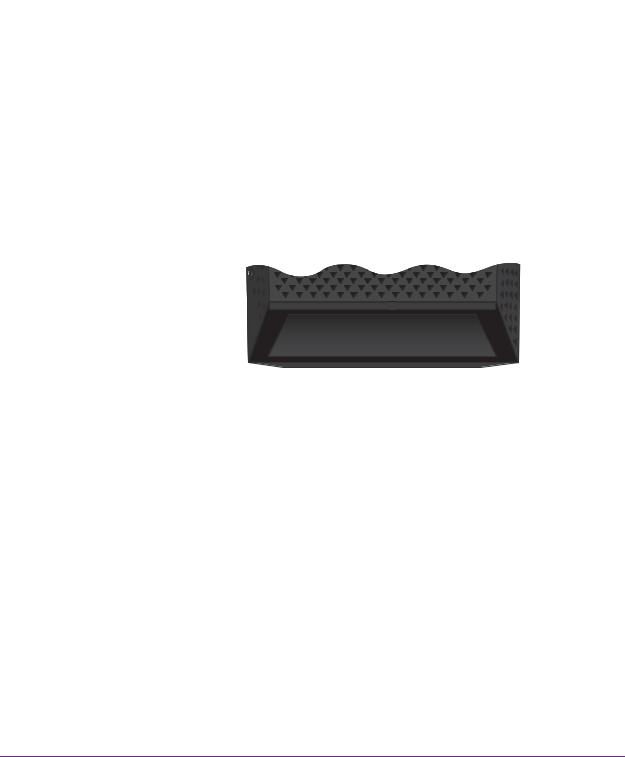
AC1600 WiFi VDSL/ADSL Modem Router Model D6400
Cable the Modem Router for DSL Service and Access the Modem Router
The following figure shows the cabling of your modem router for DSL service.
Figure 6. Modem router cabling for DSL service
To connect your modem router to a DSL service:
1.Unplug your DSL modem’s power, leaving the DSL modem connected to the wall jack for your Internet service.
2.If your DSL modem includes a battery backup, remove the battery.
3.Install an ADSL or DSL microfilter between the phone line and the phone. The product package contains either an ADSL or a DSL microfilter.
4.Use a phone cable to connect the microfilter to the gray DSL port on the modem router. The product package contains a phone cable.
5.If your DSL modem includes a battery backup, reinsert the battery.
6.Plug in your DSL modem’s power and turn on your DSL modem.
Install and Access the Modem Router and Its Network
22

AC1600 WiFi VDSL/ADSL Modem Router Model D6400
7.Connect the power adapter to the modem router and plug it into an electrical outlet. Wait for the Power LED  to light solid green, which takes about one minute.
to light solid green, which takes about one minute.
8.If the Power LED does not light, press the Power On/Off button.
9.Wait for the WiFi LED  to light blue.
to light blue.
If the WiFi LED does not light, press the WiFi On/Off button  .
.
10.Check the DSL LED.
If the modem router is connected to a DSL service, the DSL LED  lights green.
lights green.
11.Connect a computer to the modem router by one of the following methods:
•Ethernet cable. Use an Ethernet cable to connect your computer to a yellow Ethernet LAN port on the modem router.
The product package contains a yellow Ethernet cable. Your computer connects to the modem router’s LAN.
•WiFi. Connect to the default WiFi network of the modem router:
a.On your computer or WiFi device, find and select the WiFi network. The WiFi network name (SSID) is on the product label.
b.Join the WiFi network and enter the WiFi password. The password (network key) is on the product label.
Your computer or WiFi device connects to the modem router’s WiFi network.
Note: If the computer is set to a static (fixed) IP address (this setting is uncommon), either change the computer to obtain an IP address automatically from the modem router through DHCP, or change the IP address of the computer to a static IP address in the 192.168.0.2–192.168.0.254 range.
12.Launch a web browser.
The Configuring the Internet Connection page displays.
Install and Access the Modem Router and Its Network
23
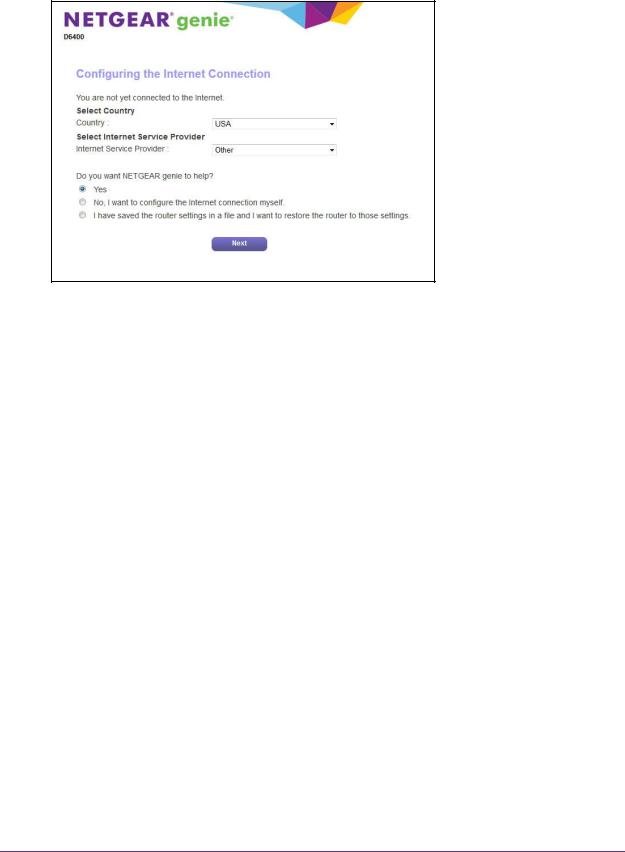
AC1600 WiFi VDSL/ADSL Modem Router Model D6400
If the Configuring the Internet Connection page displays, skip to Step 14. If it does not display, do the following:
a.In the address field of the web browser, enter www.routerlogin.net.
b.When prompted, enter admin for the user name and password for the password.
If the Configuring the Internet Connection page displays, skip to Step 14. If it still does not display, see Step 13.
13.If the browser cannot display the web page, do the following:
•Make sure that the computer is connected to one of the four Ethernet LAN ports or over WiFi to the modem router.
•Make sure that the Power LED  of the modem router is lit green.
of the modem router is lit green.
•Make sure that your browser does not cache the previous page by closing and reopening the browser.
•Clear the browser cache.
•If the computer is set to a static or fixed IP address (this setting is uncommon), either change the computer to obtain an IP address automatically from the modem router through DHCP, or change the IP address of the computer to a static or fixed IP address in the 192.168.0.2–192.168.0.254 range.
14.From the Country menu, select the country in which you use the modem router.
15.From the ISP menu, select the ISP that you are using. If your ISP is not in the menu, select Other.
16.Select the Yes radio button.
17.Click the Next button.
The Setup Wizard searches your Internet connection for servers and protocols to determine your ISP configuration.
Install and Access the Modem Router and Its Network
24
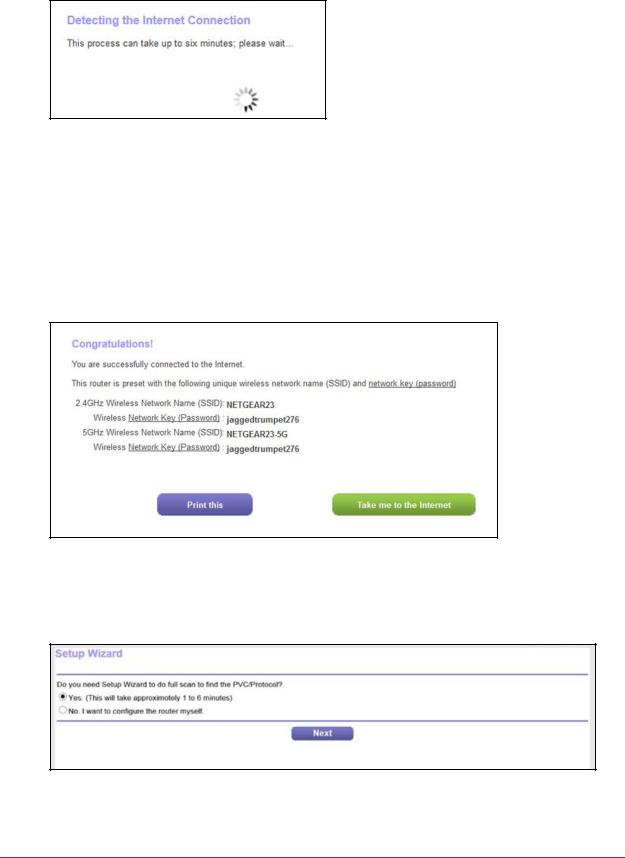
AC1600 WiFi VDSL/ADSL Modem Router Model D6400
Note: If you are connected over WiFi to the modem router, you might be disconnected during the setup process. If this situation occurs, just reconnect to the modem router and refresh the modem router’s web page.
When the modem router is connected to the Internet, the Congratulations! page displays, and you successfully completed the setup process.
If the Congratulations! page does not display, other pages might display and you might need to provide more information, in which case you must continue with the next step. The pages that display depend on your type of ISP connection and configuration.
18.(Only if you are using an ADSL connection and the following page displays) Specify a full scan to let the Setup Wizard find the PVC protocol.
The page that displays might ask you if you need the Setup Wizard to do a full scan to find the PVC protocol. If this page does not display, continue with the next step.
Install and Access the Modem Router and Its Network
25
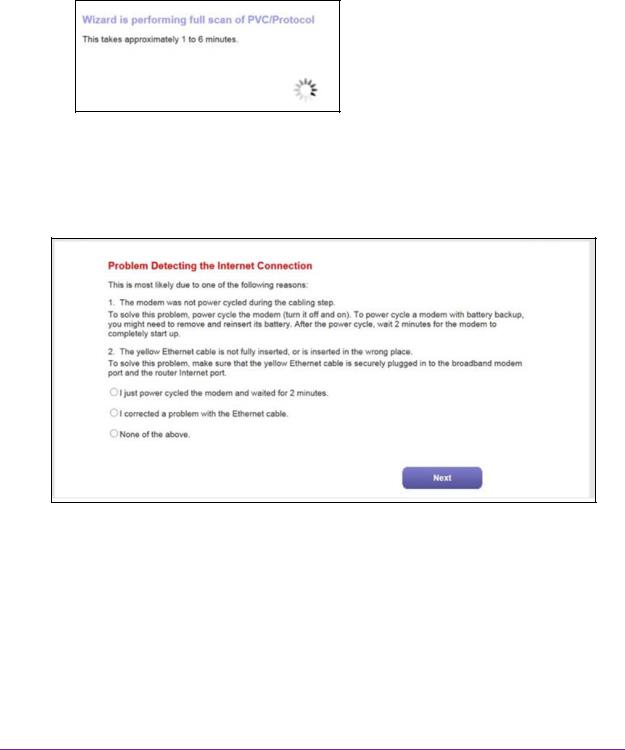
AC1600 WiFi VDSL/ADSL Modem Router Model D6400
Do the following:
a.Select the Yes radio button.
b.Click the Next button.
The Setup Wizard performs a full scan, which might take up to six minutes.
19.(Only if the following page displays) Specify how to manage problems with the detection of the Internet connection.
The page that might display states that a problem occurred while the wizard was detecting the Internet connection. If this page does not display, continue with the next step.
Note: The option for the Ethernet cable connection that is stated onscreen applies to a cable or fiber Internet connection only (see Set Up Your Modem Router for Cable or Fiber Service on page 29).
Take one of the following actions:
•If you already power cycled the DSL modem (see Step 1 through Step 6), do the following:
a.Select the None of the above radio button.
b.Click the Next button.
Install and Access the Modem Router and Its Network
26
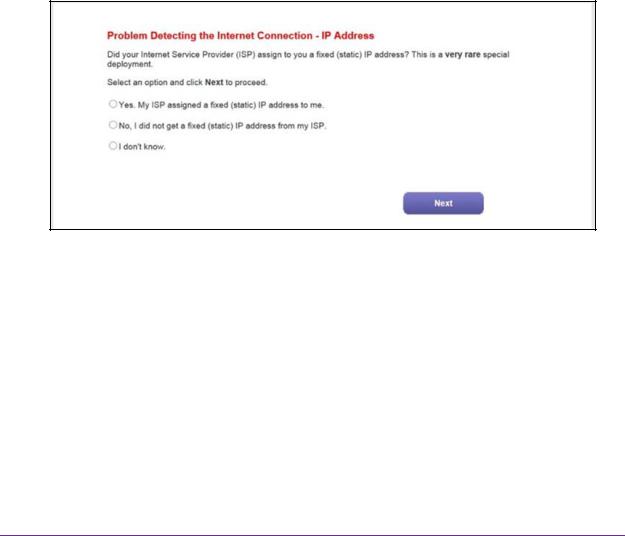
AC1600 WiFi VDSL/ADSL Modem Router Model D6400
•If you did not yet power cycle the DSL modem, do the following:
a.Unplug your DSL modem’s power, leaving the DSL modem connected to the wall jack for your Internet service.
b.If your DSL modem includes a battery backup, remove the battery.
c.Wait 10 seconds.
d.If your DSL modem includes a battery backup, reinsert the battery.
e.Plug in your DSL modem’s power and turn on your DSL modem.
f.Wait two minutes.
g.Select the I just power cycled the modem and waited for 2 minutes radio button.
h.Click the Next button.
20.(Only if the following page displays) Specify how to manage problems with the detection of the IP address for the Internet connection.
The page that might display states that a problem occurred while the wizard was detecting the Internet connection IP address.
Take one of the following actions:
•If your ISP assigned you a fixed (static) IP address, do the following:
a.Select the Yes radio button.
b.Click the Next button.
Install and Access the Modem Router and Its Network
27
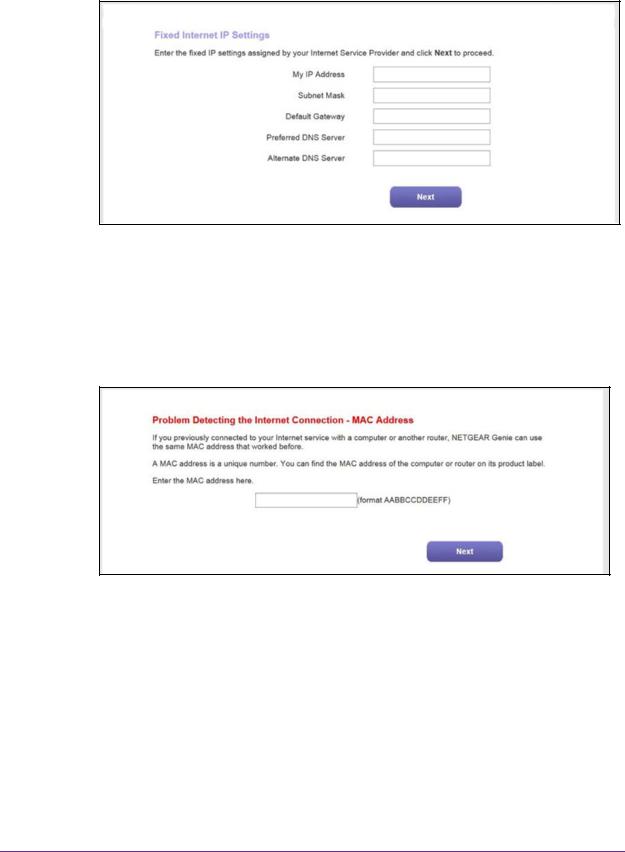
AC1600 WiFi VDSL/ADSL Modem Router Model D6400
c.Enter the address information that your ISP gave you for your fixed IP address configuration.
d.Click the Next button.
•If your ISP did not assign you a fixed IP address or you do not know if your ISP assigned you a fixed IP address, do the following:
a.Select either the No or the I don’t know radio button.
b.Click the Next button.
c.Enter the MAC address of the computer or router with which you previously were able to connect to the Internet.
You might find the MAC address on the product label of your device. Enter the MAC address in the AABBCCDDEEFF format, not in the AA:BB:CC:DD:EE:FF format.
d.Click the Next button.
21.If the Congratulations! page still does not display and the modem router still does not connect to the Internet, do the following:
a.Review all your settings.
Make sure that you selected the correct options and entered everything correctly.
b.Run the Setup Wizard one more time.
Install and Access the Modem Router and Its Network
28
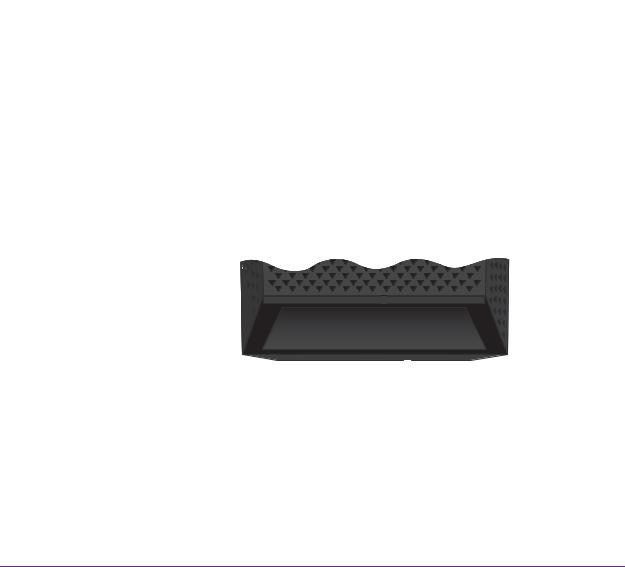
AC1600 WiFi VDSL/ADSL Modem Router Model D6400
c.Contact your ISP to verify that you are using the correct configuration information.
d.Read Troubleshoot the Internet Connection on page 276.
e.If problems persist, register your NETGEAR product and contact NETGEAR technical support.
When the modem router connects to the Internet, you are prompted to download and install the free NETGEAR Desktop genie app and the free ReadySHARE Vault app.
Set Up Your Modem Router for Cable or Fiber Service
You can install your modem router for cable or fiber (Ethernet WAN) service or for DSL service. If you use a cable or fiber modem, follow the procedure that is described in this section. If you use a DSL modem, follow the procedure that is described in Cable the Modem Router for DSL Service and Access the Modem Router on page 22.
The following figure shows the cabling of your modem router for cable or fiber service.
Figure 7. Modem router cabling for cable or fiber service
Install and Access the Modem Router and Its Network
29

AC1600 WiFi VDSL/ADSL Modem Router Model D6400
To connect your modem router to a cable or fiber service:
1.Unplug your cable or fiber modem’s power, leaving the modem connected to the wall jack for your Internet service.
2.If your cable or fiber modem includes a battery backup, remove the battery.
3.Use an Ethernet cable to connect the cable or fiber modem to the red Internet port on the modem router.
4.If your cable or fiber modem includes a battery backup, reinsert the battery.
5.Plug in and turn on your cable or fiber modem.
6.Connect the power adapter to the modem router and plug it into an electrical outlet. Wait for the Power LED  to light solid green, which takes about one minute.
to light solid green, which takes about one minute.
7.If the Power LED does not light, press the Power On/Off button.
8.Wait for the WiFi LED  to light blue.
to light blue.
If the WiFi LED does not light, press the WiFi On/Off button  .
.
9.Connect a computer to the modem router by one of the following methods:
•Ethernet cable. Use an Ethernet cable to connect your computer to a yellow Ethernet LAN port on the modem router.
The product package contains a yellow Ethernet cable. Your computer connects to the modem router’s LAN.
•WiFi. Connect to the default WiFi network of the modem router:
a.On your computer or WiFi device, find and select the WiFi network. The WiFi network name (SSID) is on the product label.
b.Join the WiFi network and enter the WiFi password. The password (network key) is on the product label.
Your computer or WiFi device connects to the modem router’s WiFi network.
Note: If the computer is set to a static (fixed) IP address (this setting is uncommon), either change the computer to obtain an IP address automatically from the modem router through DHCP, or change the IP address of the computer to a static IP address in the 192.168.0.2–192.168.0.254 range.
10.Launch a web browser.
The Configuring the Internet Connection page displays.
Install and Access the Modem Router and Its Network
30
